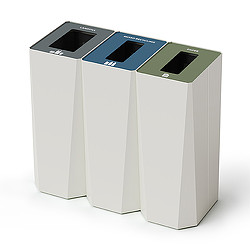Gensler has made a commitment to reduce the carbon emissions on our projects by 2030. A critical step in that process is setting sustainability standards for the products that we specify every day on behalf of our clients.
We are introducing the Gensler Product Sustainability (GPS) Standards v1.0. The GPS v1.0 standards establish sustainability performance criteria for the top 12 most commonly used, high-impact product categories selected for our architecture and interior projects.
These product categories include:
- Acoustic Ceiling Panels, Tiles, and Suspension Grids
- Batt Insulation
- Board Insulation
- Carpet Tile
- Decorative Glass
- Glass Demountable Partitions
- Gypsum Board
- Interior Latex Paint
- Non-Structural Metal Framing
- Resilient Flooring and Base
- Systems Furniture Workstations
- Task Chairs
The intent of the GPS Standards v1.0 is to provide clear and concise standards for both our teams and manufacturers and be built on industry norms while also accelerating the adoption of more aggressive targets in the near future.
The criteria were developed in alignment with initiatives by industry organizations, regulatory standards, and third-party certifications. In particular, we are collaborating with mindful MATERIALS to align with the ongoing development of the Common Material Framework to ensure consistency across the industry for a unified ask for sustainability disclosures. The GPS Standards also align with goals and criteria identified by Carbon Leadership Forum, REACH, ISO, BIFMA, LEED, BREEAM, Living Building Challenge, and the AIA Materials Pledge among others. Through our ongoing partnerships, we will expand these standards to include additional product categories and identify more aggressive sustainability targets in the future. Additionally, we are working on developing strategies for materials outside of Gensler’s direct control, such as concrete and structural steel.
Beginning January 2024, Gensler will activate these criteria in our specifications and begin evaluating products for sustainability as we would any other performance criteria. Please refer to the GPS Standards and the FAQs below for all the details.
Please select a region from the left menu
Products must meet all of the criteria listed for the product category, which are available in the Gensler Standard tab of this webpage and in Gensler’s specifications.
Gensler has been developing and iterating the 'greening' of its material selections for many years. Starting in 2022, a team of sustainability specialists, spec leaders, and technical directors from across the firm conducted a dedicated effort to rigorously research and define a clear and consistent set of standards for products across our firm. Through their expertise, research, and outreach the following key principles for the standards criteria were determined:
- Identify high-impact sustainability attributes for the product categories included in the GPS Standards. Product categories included in the standards were determined by a combination of project impacts and market readiness.
- Align criteria with industry standards and benchmarks including federal regulations, third-party building certifications, research organizations, and product databases.
- Set baseline criteria that are reflective of the current market as confirmed through compliant product research and manufacturer outreach.
- Set market differentiating criteria that communicate the current market's best-in-class sustainability attributes and reflect Gensler's sustainability goals.
- Maintain competitive bidding while limiting challenges to project schedules and project supply chains.
We will be integrating these criteria into our specifications, and products will be vetted for compliance on a project-by-project basis. Open specification items will be evaluated for compliance with minimum sustainability criteria alongside the rest of Gensler’s performance criteria.
Compliance may be demonstrated by reporting sustainability attributes via product data sheets, technical bulletins, and by making third-party verified sustainability documentation publicly available. Sustainability information will be assessed during project submittal reviews.
Gensler created these criteria in alignment with public databases that keep their product data current. We encourage manufacturers to report all sustainability attributes for their products in third-party product databases.
No, Gensler will not be publishing or creating a list of compliant products. See answer above for how Gensler is advocating for increased reporting to product databases.
In order to be clear and concise, the GPS Standards do not focus on naming every acceptable declaration, certification, or form of documentation. So long as the certification uses the applicable testing standards or methodologies named in the GPS Standards, the certification complies.
Acceptable VOC Emissions testing methodologies include California Department of Public Health Standard Method v1.2 (or later), ANSI/BIFMA M7.1-2016 (or later), Ausschuss zur Gesundheitlichen Bewertung von Bauprodukten (AgBB), EN 16516, EN-717-1:2004 (or later), or ISO 16000.
Multi-attribute certifications such as Cradle to Cradle v.4, BIFMA LEVEL, and Living Product Challenge may satisfy the standard requirements for Indoor Air Impacts, Material Health & Transparency, and Lifecycle Impacts except EPD requirements where applicable. Product categories with EPD requirements and/or Global Warming Potential (GWP) thresholds are still required to disclose the GWP of the product via a third-party verified EPD, regardless of multi-attribute certification.
As long as certifications are valid at the time of project submittal review, they are compliant.
No. Gensler’s product specifications are made based on many factors related to performance, aesthetics, and cost, as they relate to the specific project. As such, Gensler cannot guarantee that any product will be specified, but compliance with our GPS Standards will allow Gensler project teams and their clients to consider your product alongside other products with similar qualifications.
At present, the GPS Standards are specific to the US, Canada, the EU, and the UK. In the future, we will be evaluating product sustainability standards for other regions where Gensler operates.
No. Manufacturers are not permitted to claim their products are certified by Gensler.
Market Differentiator criteria are not required. These criteria were identified for clients and projects wishing to go further than the standard, but with an understanding that there may be cost or availability issues for the products they seek. Market Differentiator criteria are also a means for us to communicate to manufacturers the attributes that we'd like to see in the future as products are developed and improved.
- Meet the Global Warming Potential limit for the product category; and
- Meet the recycled content threshold (where applicable); and
- Meet one of the following:
- Provide either a Multi-Attribute Certification
- Meet the requirements for chemicals of concern (i.e. LBC Red List, Cradle to Cradle Material Health Certificate, or avoid the named Chemicals of Concern).
A publicly available action plan or statement addressing your company’s commitment to sustainable practices, with clear actions intended to be met within a defined timeframe is valid. Environmental, Social, and Governance (ESG) and Corporate Social Responsibility (CSR) reports satisfy this standard requirement although they are considered market differentiators.
For the product categories with EPD requirements, EPDs must be third-party verified and reported in accordance with ISO 14025, ISO 21930, or EN 15804. This requirement applies to both product specific EPDs (reflect the manufacture of a particular product by a specific manufacturer) and industry-wide EPDs (reflect generic baseline information for a specific product category).
EPDs must be appropriate to the geographic scope of manufacture. Non-domestic EPDs will be accepted only in the absence of domestic production.
Gensler only accepts industry-wide EPDS from participating manufacturers.
In the GPS Standards, Global Warming Potential refers to the sum of the ISO 14025 Stage A1-A3 (Raw material supply, Transport, and Manufacturing) total global warming potential impacts over 100 years (GWP-100), measured in kilograms carbon dioxide equivalent (kg CO2e) per functional unit according to the Product Category Rule, as reported in the product’s EPD. For products manufactured in the United States, US EPA TRACI 2.1 indicators should be used. For all other locations, CML indicators are acceptable.
Biogenic carbon removal or sequestration in Stages A1-A3 can be accounted for in the total GWP following ISO 14067 and ISO 14025/EN 15804 only for sustainably harvested materials. All other types of sequestration and offsets not reportable in Stages A1-A3 are not included in the GWP values. .
We are committed to providing our clients and industry partners with every opportunity to work with us to reduce the carbon footprint of their projects. The availability of low-carbon products and reliable data to understand the carbon impacts of material selection is critical to the success of that mission.
We are prioritizing the materials which have the largest impact on our projects’ embodied carbon footprints, have a sufficient volume of product-specific EPDs available, and which demonstrate a sufficient range of performance to make product-based substitution a meaningful decarbonization strategy. If these criteria are not yet met, we encourage manufacturers to publish EPDs for their products and create an optimization plan. We intend to continue updating the GPS Standards by adding targets for more categories as carbon data matures.
Biobased products are derived from plants and other renewable agricultural, marine, and forestry materials. Biobased products provide an alternative to conventional petroleum derived products.
SOURCE: U.S. Department of Agriculture
Compliant products have been tested according to California Department of Public Health (CDPH) Standard Method v1.2–2017 and comply with the VOC limits in Table 4-1 of the method. Additionally, the range of total VOCs after 14 days (336 hours) was measured as specified in the CDPH Standard Method v1.2 and is reported (TVOC ranges: 0.5 mg/m3 or less, between 0.5 and 5 mg/m3, or 5 mg/m3 or more)." Laboratories that conduct the tests must be accredited under ISO/IEC 17025 for the test methods they use. Products must be modeled to private office scenario.
SOURCE: USGBC
Chemicals of concern are chemical substances found to be harmful or toxic to human health and the environment.
A self-regulating business practice that measures the impact of an organization’s activities on society and the environment. This is achieved through transparent and ethical behavior that contributes to sustainable development, including the health and welfare of society; acknowledges the expectations of stakeholders and customers; complies with applicable laws and is consistent with international norms; applies to the entire organization and is reflected in relationships with external stakeholders.
SOURCE: Ecovadis
Designing products to ensure that they can be upgraded, remanufactured, and or recycled. Products shall be designed in a modular fashion to facilitate the repair or replacement of components that are subject to wear or breakage or likely to be upgraded. Maximize the degree to which materials from the product that cannot be reused or remanufactured can be recycled. Provide verification of recyclability of other constituent materials in accordance with the U.S. Federal Trade Commission Green Guides or in accordance with applicable environmental marketing guidelines in the country in which the product is manufactured.
SOURCE: BIFMA e3-2019
Refers to the various ways a product or material may be disposed of, repurposed, repaired, recycled, downcycled, or recirculated. Examples include: designed for durability/repair/retrofit/recycling, design for recyclability, extended producer responsibility programs (manufacturer take back programs), products as services, closed loop recycling programs, third-party partnerships for product recovery and cycling.
An Environmental Product Declaration (EPD) is a standardized document prepared by a manufacturer that reports objective, comparable and third-party verified information on the environmental impact of a product or system over the course of its lifecycle in accordance with ISO 14025, ISO 21930, or EN 15804. Environmental impacts reported in an EPD include a product’s Global Warming Potential.
An EPR Program consists of measures undertaken by the maker of a product to accept its own and sometimes other manufacturers’ products as post-consumer waste at the end of the products’ useful life. Producers recover and recycle the materials for use in new products of the same type. For carpet, extended producer responsibility must be consistent with NSF/ANSI 140–2007. Also known as closed-loop program or product take-back.
SOURCE: USGBC
The Global Warming Potential (GWP) is a standardized unit of measure of contribution to the greenhouse effect driving climate change. Specifically, it is a measure of how much energy the emissions of 1 ton of gas will absorb over a given period of time, relative to the emissions of 1 ton of carbon dioxide (CO2).
Any mineral wool batt or board insulation with a density of between 4.4-8 lbs/ft3 (70-128 kg/m3)
Products that are inherently nonemitting sources of VOCs (stone, ceramic, powder-coated metals, plated or anodized metal, glass, concrete, clay brick, and unfinished or untreated solid wood) are considered fully compliant without any VOC emissions testing if they do not include integral organic-based surface coatings, binders, or sealants. Untreated and unfinished solid wood (not engineered wood) can also be considered nonemitting even though such materials will likely emit some amount of formaldehyde naturally.
SOURCE: USGBC
Assessments that provide an inventory of all ingredients present in a material or product, identified by name and the CASRN and/or EC Number, and checked against a relevant database for potential health and environmental hazards.
The Living Building Challenge (LBC) Red List represents the “worst in class” materials, chemicals, and elements known to pose serious risks to human health and the greater ecosystem that are prevalent in the building products industry. Compliance with this criteria may be met through a manufacturer’s letter of assurance that a product has been screened for and does not contain red list ingredients at a minimum disclosure threshold of 1000ppm.
A standardized way of quantifying the environmental impact of a product or system, including but not limited to embodied carbon. LCAs must be conducted in accordance with ISO 14044, and report a product’s Global Warming Potential.
A compliant embodied carbon optimization report or action plan, separate from the LCA or EPD, that demonstrates reductions in environmental impacts over time.
SOURCE: USGBC
Any mineral wool batt or board insulation with a density of less than 4.4 lbs/ft3 (<70 kg/m3)
The facility in which the final assembly of a product occurs. In a Life-Cycle Assesment, this would be the final facility before the A4 phase.
These are certifications measuring multiple areas of sustainability including but not limited to: embodied carbon, material health, indoor emissions, social fairness, product circularity, and water use.
Multi-attribute certifications such as Cradle to Cradle v.4 and Living Product Challenge may satisfy the standard requirements for Indoor Air Impacts, Material Health & Transparency, and Lifecycle Impacts, except EPD requirements where applicable. Product categories with EPD requirements and/or Global Warming Potential (GWP) thresholds are still required to provide EPDs and disclose the GWP of the product via a third-party verified EPD, regardless of multi-attribute certification.
Environmental commitments made at an organizational or company-wide level . This is not intended to be an exhaustive list, and therefore equivalent programs and/or pledges may be recognized as fulfilling this criteria.
Waste generated by households or commercial, industrial and institutional facilities in their role as end users of a product that can no longer be used for its intended purpose.
SOURCE: USGBC
Matter diverted from the waste stream during the manufacturing process, determined as the percentage of material, by weight. Examples include planer shavings, sawdust, bagasse, walnut shells, culls, trimmed materials, overissue publications, and obsolete inventories. The designation excludes rework, regrind, or scrap materials capable of being reclaimed within the same process that generated them (ISO 14021). Formerly known as postindustrial content.
SOURCE: USGBC
Physical product and services to maintain a product's use through design, use, maintenance, reuse, remanufacture, and recycling.
SOURCE: Article
The Science Based Targets initiative (SBTi) promotes best practices and well-defined guidelines to reduce emissions and provides target-setting methods based on climate science. The initiative helps businesses set carbon reduction goals compliant with the Paris Agreement Targets. Science-Based Targets (SBTs) focus on the number of emissions that needs to be decreased to comply with the targets set out in the Paris Climate Agreement
SOURCE: Science Based Targets
A publicly available inventory of all ingredients identified by name and Chemical Abstract Service Registration Number (CASRN) and/or European Community Number (EC Number). Materials defined as trade secret or intellectual property may withhold the name and/or CASRN/EC Number but must disclose ingredient/chemical role, amount and hazard score/class using either: Greenscreen List Translator (LT) score and/or Full GreenScreen Benchmark (BM), The Globally Harmonized System of Classification and Labeling of Chemicals rev.6 (2015) (GHS). The hazard screen must be applied to each trade secret ingredient and the inventory lists the hazard category for each of the health hazards included in Part 3 of GHS (e.g. “GHS Category 2 Carcinogen”).
SOURCE: USGBC
The management of environmental and social impacts within and across networks consisting of suppliers, manufacturers, distributors, and customers in line with the UN Sustainable Development Goals. This spans every phase of the supply chain, from raw materials sourcing and extraction to product use and end of product life.
SOURCE: MIT Center for Transportation & Logistics and Council of Supply Chain Management Professionals
A publicly available action plan or statement addressing your company’s commitment to sustainable practices with clear actions intended to be met within a defined timeframe.
Systems furniture is defined as either a panel-based workstation comprised of modular interconnecting panels, hang-on components and drawer/filing components or a freestanding grouping of furniture items and their components that have been designed to work in concert.
SOURCE: USGBC
Third-party validation of a product recovery program’s capacity to recycle, either into new products or into other product applications, 100% of the materials recovered.
Partnering with outside organizations to divert products from landfills and find alternative applications that eliminate the need for additional raw material extraction.
A volatile organic compound (VOC) is any compound of carbon, excluding carbon monoxide, carbon dioxide, carbonic acid, metallic carbides or carbonates, and ammonium carbonate, which participates in atmospheric photochemical reactions. As gases, VOCs are emitted into the air from products or processes and are often harmful to human health and to the environment by themselves, as well as by reacting with other gases to form other air pollutants after they are in the air.
SOURCE: ILFI Program Glossary
GPS Standards are subject to change as industry standards and requirements evolve, and updates will be sent to you automatically at the email address you provided when downloading product-specific GPS PDFs. At this point, our standards are exclusive to products made and/or distributed in the U.S., Canada, and Europe, with other regions currently being developed. Finally, please note that GPS Standards focus exclusively on sustainability criteria and shall not be construed as replacing any other performance criteria or requirements set forth by applicable laws, codes, regulations, etc.
Thank you for your ongoing partnership as we work together to create a better world through the power of design.



















